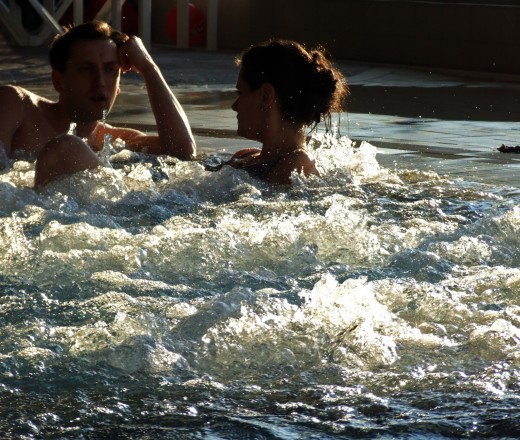Hydrotherapy Benefits and Hot Tubs
Hydrotherapy baths
Historically, man has always been drawn to water. I’m not talking about the fact that water is required for survival in the form of drinking water and water for crops and food animals. I’m talking about how humans enjoy immersing their bodies in water.
I can’t imagine a single person who doesn’t enjoy a refreshing shower or a nice bubble bath. Soaking in a warm bathtub both relaxes and rejuvenates us. Most everyone knows that warm or hot water has the power to relieve stress, but it has other capabilities, as well.
What is hydrotherapy?
The use of water for curative purposes is called hydrotherapy. Hydrotherapy baths have been used for thousands of years, even before the term was invented. The ancient Greeks often took therapeutic baths, and the ancient Romans turned the practice into an art, complete with public bath houses that provided hydrotherapy benefits. The ancient populations of China, Japan, and Egypt also enjoyed hydrotherapy baths. Native Americans believed that natural hot springs had amazing curative properties and often took their sick and wounded to the springs for hydrotherapy benefits.
In Europe, towns and spa resorts grew up around natural hot springs. For example, in Germany, the hot mineral springs of Baden-Baden became a popular site for royalty and aristocrats. In the UK, the city of Bath was established as a spa resort by the Romans in the year 43, even though the hot springs had been enjoyed before then. Every continent has hot springs that occur naturally.
My home state of Georgia has a rather famous hot spring that’s located about 100 miles south of Atlanta, in the town aptly named Warm Springs. The hillside springs were once used by the Creek Indians to cure their sick and wounded. When polio broke out later, many people, including President Franklin D. Roosevelt, believed the hot springs could alleviate their condition. Roosevelt was so impressed with the springs that he had the Little White House built nearby.
Hydrotherapy treatment can include applications of both hot or warm and cold water, but I’m not going the cover the uses of cold-water hydrotherapy in this article. I’m sticking to warm and hot water hydrotherapy like that found in a hot tub because that’s what I use and know the most about.
Benefits of hot tubs, spas, and hydrotherapy treatment
Of course, to achieve hydrotherapy benefits, people can visit an expensive spa, or they can turn their hot tubs into hydrotherapy tubs or thermospas. This is easy to do. All you have to tweak is the temperature setting to use hot tubs as hydrotherapy tubs or home thermospas.
Hydrotherapy treatment works in a number of ways, some of which even doctors don’t fully understand. For one thing, it’s the heat of the water that’s important in hydrotherapy benefits. Heat serves as sort of a tranquilizer for the body. The thermal effect slows down the internal organs and decreases the production of stress hormones. That’s one reason a warm bath or time spent in hot tubs or thermospas is so relaxing.
Another aspect of a hydrotherapy tub or spa tub is the weightlessness. Your body is temporarily relieved of the demands of gravity, giving muscles and supportive tissues a chance to rest. The weightlessness combined with the heat of the water has the ability to relieve fatigue and stiff joints.
When water moves, as it does in a hot tub or spa tub, the water essentially massages the body. Nerve endings just under the skin are stimulated, as are reflexes on the spinal cord. Muscles and nerves tend to relax, creating an overall soothing effect on the body. People who take a hot bath or relax in a hot tub shortly before bedtime report better sleep. They fall asleep more quickly, sleep more soundly, and are able to sleep for longer periods without waking after hydrotherapy baths.
In a hot tub, the water doesn’t just move, it moves forcefully via jets. The jetted water can be directed to aching muscles and joints, providing quick pain relief. And in most hot tubs and spa tubs, there are numerous jets in several locations, so more than one area of the body can be focused on at the time.
Since hot water causes the blood vessels to dilate, sitting in a hot tub can increase circulation. It’s also believed to remove wastes from tissues and to aid the immune system.
Does hydrotherapy really work?
The positive effects of hydrotherapy have been proven in several studies. In 1995, the British Journal of Rheumatology reported that hydrotherapy baths have both short and long term benefits to those suffering from back pain. Researchers in France also reported that back pain sufferers experienced greater flexibility and less pain when using regular hydrotherapy treatments.
In 1996, Arthritis Today reported that people with painful arthritis had less pain and needed fewer analgesics and anti-inflammatories when they followed a hydrotherapy treatment plan.
Hydrotherapy and back pain
I have a lot of back stiffness and back pain, especially lower back pain. Moist heat is a wonderful treatment for back pain, and my hot tub provides that. When I'm having lower back pain, I get in my hot tub and position myself so that a jet is aimed right at my lower back pain, and the relief is immediate!
Hot tub safety tips
- To relieve pain from arthritis, muscle spasms, strains, and backache, the temperature of the water should be 102-104 degrees. For hot tub safety, some doctors recommend keeping temperatures below 104 degrees.
-To relieve stress, the water temperature should be close to the temperature of the skin, about 94 degrees.
-Don’t get in a hot tub if you’re pregnant or think you might be pregnant.
- Don’t stay in a hot tub longer than 15 minutes at a time. This is an important part of hot tub safety.
- Children and the elderly should not get in a hot tub in which the water is heated to above 95 degrees and should stay in no longer than 10 minutes.
- Those with diabetes, heart disease, or high or low blood pressure should consult their physician before using a hot tub.
Read more about hot tubs, pools, and hydrotherapy:
- Above Ground Swimming Pools: Many Benefits!
I love swimming pools. We had an above ground swimming pool when I was a kid, and it provided us with several years of enjoyment. When Mom got tired of it, my parents took it down and gave it to my uncle.... - Kids' Pool Toys at Discount Prices!
Looking for kids pool toys for inground pools or above ground pools? Good for you! In my half century on earth, Ive had three above ground swimming pools. In fact, I have one in my back yard right now,... - Latest Trends: Shower Steamer
If you've ever enjoyed a steam bath or a steam shower, chances are that it was at a spa, club, gym, or another commercial steam room of some sort. You had to pay for membership or either pay a... - Why to Buy a Hot Tub
A few years ago, I started having a lot of pain in my neck that radiated into my shoulder and down my left arm. I also had pain in my lower back that radiated down my right leg. I went to a couple of doctors...









